7.6 Plasma spraying
A number of processes have been developed where particles of coating material are heated to a molten state and projected at a substrate which is relatively cold (
A plasma – a superheated gas – is formed by using an inert (unreactive) gas such as argon with a small amount of hydrogen or helium and then applying a high energy electric arc at typically 40 kV. The material for the coating is fed into the gun, as a fine powder, down the powder feed. The powder melts in the plasma and the gas expands rapidly and accelerates the molten droplets to speeds of 250–500 m s−1. The process conditions must be carefully controlled so that the coating adheres well to the substrate. This ensures that any friction and wear causes the coating to wear away rather than peel away from the surface. Ideally, the coatings that are produced have low porosity and good mechanical strength.
